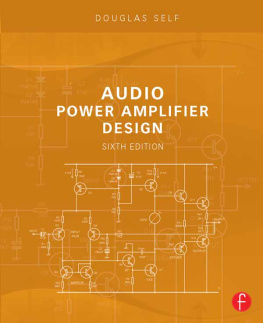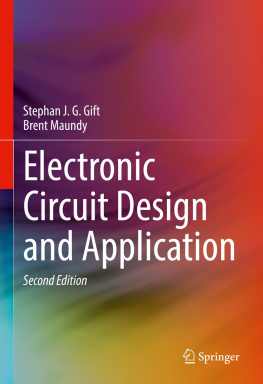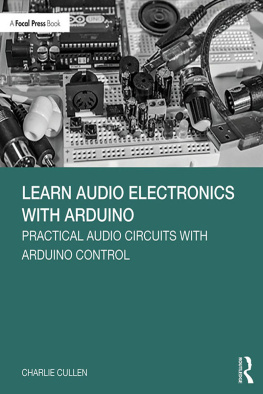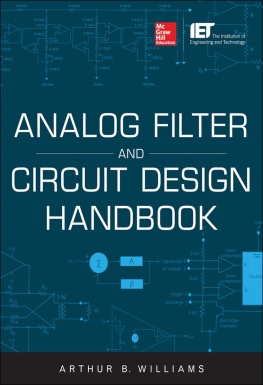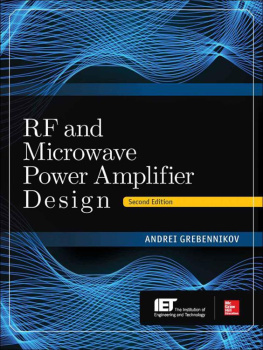Douglas Self - Audio Power Amplifier Design
Here you can read online Douglas Self - Audio Power Amplifier Design full text of the book (entire story) in english for free. Download pdf and epub, get meaning, cover and reviews about this ebook. City: New York, year: 2013, publisher: Focal Press, genre: Science / Computer. Description of the work, (preface) as well as reviews are available. Best literature library LitArk.com created for fans of good reading and offers a wide selection of genres:
Romance novel
Science fiction
Adventure
Detective
Science
History
Home and family
Prose
Art
Politics
Computer
Non-fiction
Religion
Business
Children
Humor
Choose a favorite category and find really read worthwhile books. Enjoy immersion in the world of imagination, feel the emotions of the characters or learn something new for yourself, make an fascinating discovery.
- Book:Audio Power Amplifier Design
- Author:
- Publisher:Focal Press
- Genre:
- Year:2013
- City:New York
- Rating:4 / 5
- Favourites:Add to favourites
- Your mark:
- 80
- 1
- 2
- 3
- 4
- 5
Audio Power Amplifier Design: summary, description and annotation
We offer to read an annotation, description, summary or preface (depends on what the author of the book "Audio Power Amplifier Design" wrote himself). If you haven't found the necessary information about the book — write in the comments, we will try to find it.
Audio Power Amplifier Design — read online for free the complete book (whole text) full work
Below is the text of the book, divided by pages. System saving the place of the last page read, allows you to conveniently read the book "Audio Power Amplifier Design" online for free, without having to search again every time where you left off. Put a bookmark, and you can go to the page where you finished reading at any time.
Font size:
Interval:
Bookmark:
Audio Power Amplifier Design
Audio Power Amplifier Design
Sixth Edition
Douglas Self

This edition published 2013
by Focal Press
70 Blanchard Rd Suite 402, Burlington, MA 01803
Simultaneously published in the UK
by Focal Press
2 Park Square, Milton Park, Abingdon, Oxon OX14 4RN
Focal Press is an imprint of the Taylor & Francis Group, an informa business
2013 Douglas Self
The right of Douglas Self to be identified as the author of this work has been asserted by him in accordance with sections 77 and 78 of the Copyright, Designs and Patents Act 1988.
All rights reserved. No part of this book may be reprinted or reproduced or utilised in any form or by any electronic, mechanical, or other means, now known or hereafter invented, including photocopying and recording, or in any information storage or retrieval system, without permission in writing from the publishers.
Notices
Knowledge and best practice in this field are constantly changing. As new research and experience broaden our understanding, changes in research methods, professional practices, or medical treatment may become necessary.
Practitioners and researchers must always rely on their own experience and knowledge in evaluating and using any information, methods, compounds, or experiments described herein. In using such information or methods they should be mindful of their own safety and the safety of others, including parties for whom they have a professional responsibility.
Product or corporate names may be trademarks or registered trademarks, and are used only for identification and explanation without intent to infringe.
Library of Congress Cataloging in Publication Data
Self, Douglas.
Audio power amplifier design / Douglas Self. Sixth edition.
pages cm
1. Audio amplifiersDesign and construction. 2. Power amplifiersDesign and construction. I.
Title.
TK7871.58.A9S45 2013
621.3893dc23
2012048301
ISBN: 978-0-240-52613-3
ISBN: 978-0-240-52614-0
Typeset in Times New Roman
By TNQ Books and Journals, Chennai, India

This book is dedicated to Julie,
with all my love, and with gratitude
for all her help and support in the endeavour
Contents
This book appeared in its Fifth edition in 2009. Since then I have done a good deal of research to improve our knowledge of solid-state power amplifiers and their design issues, partly in the course of my consultancy work, and partly in the spirit of scientific enquiry. As a result this edition has been greatly extended, the number of chapters increasing from 21 to 30.
The many new topics include: the characteristics of the audio signal, the principles of distortion, error-correction, non-switching output stages, the details of VAS distortion, push-pull VAS configurations, op amp-array power amplifiers, series output stages, output-inclusive compensation, the optimisation of output coils, the power dissipation in various kinds of amplifiers, and a brief history of solid-state amplification. A complete procedure for designing the heatsinking and power supply is given, going down to the detail of fuse ratings and reservoir ripple-current. Five amplifier design examples that illustrate important design principles are closely examined.
The only material that has been removed is that dealing with some of the more specialised types of balanced line input stages. This information can now be found, in much expanded form, in my book, Small Signal Audio Design. However, the line input chapter has also had some completely new material added on instrumentation amplifiers which is of special importance to power amplifiers.
A criticism sometimes voiced of previous editions of this book was that it focused mainly on one configuration, the three-stage amplifier consisting of an input differential pair with current-mirror load, driving a constant-current Voltage-Amplifier Stage (VAS), which is enhanced by adding either an emitter-follower inside the Cdom loop, or a cascode transistor to the VAS collector. The VAS then drives a unity-gain output stage. This may be the most conventional configuration of the lot, but it has become clear that it also the most effective and economical, so it still forms the basis of this book. My recent researches underlined how free of vices and complications it is, compared with other configurations that on the surface appear more sophisticated. In particular the push-pull VAS has now been thoroughly investigated, and two well-known forms of it have been found to be unsatisfactory, though a third is workable. There seems no need to ever go to the extra complication of a four-stage amplifier.
I believe that this edition goes a level deeper than ever before in describing power amplifier behaviour. A major contribution to this has been made by Samuel Groner in his commentary on the Fifth edition of this book. The commentary should be read by anyone with an interest in power amplifier design; it can be found on his website at http://www.sg-acoustics.ch/analogue_audio/index.html. It was this that led me to study VAS distortion more closely, and I can say that in every topic that I have explored, I have found Samuel's findings to be absolutely correct.
Perhaps the most important new information in this edition is that relating to methods of compensation that are more advanced than the near-universal Miller dominant pole. I describe how to make a stable amplifier in which the output stage is enclosed in the Miller loop. This allows much more negative feedback to be applied to the stage which generates the troublesome crossover distortion, and the improvement in linearity is dramatic. describes the performance of two amplifiers with output-inclusive Miller compensation. One version gives 0.00078 % (7.8 ppm) at 10 kHz and 0.002% (20 ppm) at 20 kHz. At the time of writing this is something of a Personal Best.
The distortion performance is considerably better than that obtainable from a straightforward Blameless amplifier, and I consider it needs a name of its own. In short, it is an Inclusive Amplifier. Beyond Blameless!
demonstrates that Class-A amplifiers are not just inefficient; with musical signals they are hopelessly inefficient somewhere around 1%. There is now really no need to resort to Class-A just to get low distortion, so their attraction is as much philosophical as anything else. I believe you should think hard before planning to build one with more output than about 20 W/8 U.
Interest in vintage hi-fi, especially pre and power amplifiers of the 1970s and 1980s, has increased greatly in the last few years; in response to this I have added many references to significant models and their technologies. (The date of introduction is in brackets after the model name.) I have also added a chapter that gives a brief overview of the development of solid-state amplifiers; how we got from there to here. One strand of amplifier history is the intriguing topic of amplifiers with non-switching output stages; this topic seems to be surfacing on the audio bulletin boards with increasing frequency at present. It is therefore extensively described in .
My research into power amplifier design is an ongoing activity. It is has not been possible to tie everything up neatly, and at a few points I have simply had to say This is as far as I have got.
This is the only power amplifier book that is filled with measurements conducted on real amplifiers rather than with simulations of dubious accuracy. The new measurements for this edition were done using the state-of-the-art Audio Precision SYS-2702 THD analyser, and show lower noise and lower distortion residuals in the LF regions of the distortion plots. I have not yet tackled the Herculean task of repeating every measurement in the Fifth edition, so please bear in mind that many of these were done with an AP System 1, and this accounts for some apparent differences in performance.
Next pageFont size:
Interval:
Bookmark:
Similar books «Audio Power Amplifier Design»
Look at similar books to Audio Power Amplifier Design. We have selected literature similar in name and meaning in the hope of providing readers with more options to find new, interesting, not yet read works.
Discussion, reviews of the book Audio Power Amplifier Design and just readers' own opinions. Leave your comments, write what you think about the work, its meaning or the main characters. Specify what exactly you liked and what you didn't like, and why you think so.

